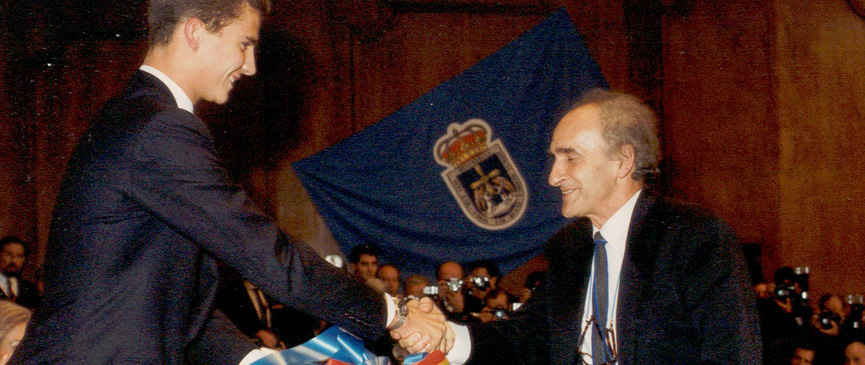The Princess of Asturias Foundation
Sección de idiomas
Fin de la sección de idiomas
Sección de utilidades
Fin de la sección de utilidades
- The Foundation
- HM The King
- HRH The Princess of Asturias
- 2023 Special
- Princess of Asturias Awards
- Area of Communication and Media
- Music Department
- Exemplary Town of Asturias Award
- 2012 Special
- 2013 Special
- 2014 Special
- 2015 Special
- 2016 Special
- 2017 Special
- 2018 Special
- 2019 Special
- 2020 Special
- 2021 Special
- 2022 Special
-
Important: COVID-19
-
Terms of Use
You are in:
Laureates
Start of main content
Eduardo Chillida
Prince of Asturias Award for the Arts 1987

The sculptor Eduardo Chillida (San Sebastián, España 1924 - 2002) was one of the most outstanding figures of the Spanish visual arts scene. After abandoning his studies in Architecture, he moved to France to devote himself to sculpture, first living in Paris and later in Villenes. At the age of 26, he returned to the Basque Country and settled in Hernani, where he made his first work in iron and learned the secrets of the forge and handling the bellows from the village blacksmith.
Before becoming a sculptor, he had been the goalkeeper of Real Sociedad football club, a sport he was forced to abandon due to an injury. Chillida has always spoken about the close relationship between being a goalkeeper in football and a sculptor: a cosmos in which space, limit and matter come into play. In 1951, he created his first non-figurative work, “Ilarik”, in which awareness of space was outlined as a material and, at the same time, symbolic element. After working in iron for ten years, including the doors of the Basilica of Aránzazu (1954), he returned to large granite sculptures at the start of the 1960’s. After presenting his first exhibition in Madrid in 1954, different works and also successes followed one after another: diplomas of honour at the Milan Triennial (1954), first individual show in Paris (1956), the Grand Prix for Sculpture at the Venice Biennial (1958), the Kandinsky Prize in Paris (1960), the Providence, Rhode Island Arts Club prize (1961) and the Wilheim Lehmbruch Prize (1966), among others. The works of Eduardo Chillida are spread over America and Europe. In 1980, he gave a great retrospective exhibition of his work in the “Crystal Palace” in the Retiro Park, Madrid.
In the opinion of some critics, Chillida’s evolution as a sculptor has been marked by rebellion. The artist himself pointed to Architecture as the element which is capable of releasing this inner rebellion. This constant pushing back of the limits of the means of construction is what has given his work its originality, his monumental pieces their lightness, and which has allowed such solid elements as concrete and steel to be freed of their heaviness, without losing their own being. In his early years, he used his left hand to draw, fleeing from the ease of using his right hand. This brake, the retardant element, this initial clumsiness, allowed him to create a space for reflection and, at the same time, to direct his work, not so much towards what is easy or already known, but rather towards what is unknown and difficult. Among his best- known works, those that stand out are “El peine de los vientos” [The Comb of the Winds] and “La case del padre” [The Father’s House], a tribute to the tree of Guernica in the town itself in Bizcaya. His work “Elogio al horizonte” [Eulogy to the Horizon], installed in Gijón, is considered one of the high points of his artistic career. Other important works include: “Rumor de Límites” (1960), “Estela a Salvador Allende” (1974), “Iru Zulu” (1975), “Arquitectura heterodoxa” (1978), “Tolerancia para el diálogo” (1993) and “Esparantza” (2000). Chillida showed great mastery in numerous drawings, among which his hand drawings, xylographs and etchings are noteworthy. His graphic work has appeared in the company of texts by Heidegger, Jorge Guillén, Cioran, Edouard Jabés and Max Holzer. Alongside his work in sculpture, he also produced a small, but very interesting output of paintings.
In 2000, Bilbao City Council gave his name to a plaza where his work “Lugar de encuentros IV” [Meeting Place IV] was installed. That same year, he opened his museum, Chillida-Leku, in Hernani, where he was invested with an honorary doctorate by the Complutense University of Madrid. Among many other honours and distinctions, he received the Gold Medal of Fine Arts (1981) and the European Prize (1983). He was named Honorary Architect by the Higher Council of Architectural Colleges of Spain, Foreign Honorary Member of the American Academy of Arts and Sciences of Cambridge (Massachussets), Honorary Member of the American Academy of Arts and Letters of New York, Honorary Member of the Royal Academy of Fine Arts of San Fernando (Madrid) and, in 2002, the Academy of Architecture of Paris awarded him the Arts Medal for his body of work as a whole.
End of main content
Sección de utilidades
Fin de la sección de utilidades
- Legal document Legal document (Access key 8)
- | Privacy policy Privacy policy (Access key )
- | Social networks ???en.portal.pie.menu107.title???
- | Cookies ???en.portal.pie.menu110.title???
- | Site map Site Map (Access key 3)
- | Contact Contact (Access key )
- | XHTML 1.0
- | CSS 2.1
- | WAI 'AA
© Copyright 2024. FUNDACIÓN PRINCESA DE ASTURIAS



